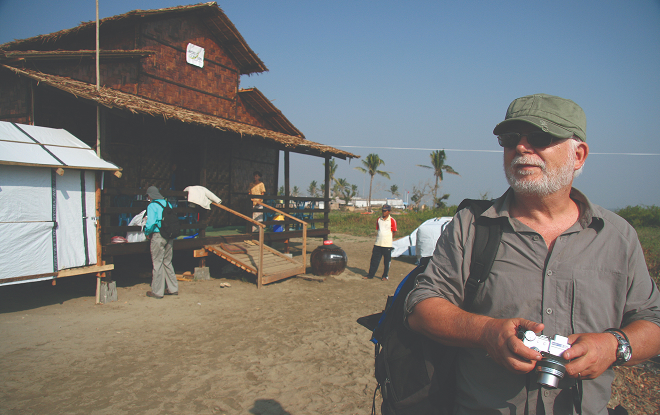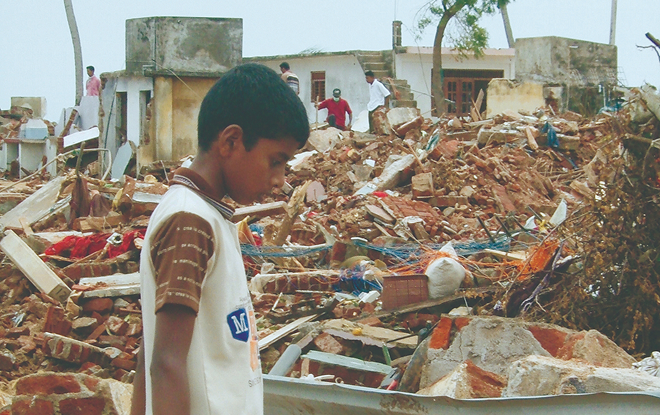Two Tearfund CEOs and the Disaster that Unites Them
418 0
On opposite sides of the world, two men faced the same disaster in strikingly different ways. In Sri Lanka, current-CEO, Ian McInnes, was on holiday with his wife when a devastating tidal wave hit the coast of Sri Lanka. Meanwhile in New Zealand, former-CEO Steve Tollestrup was watching the same tsunami unfold in real time on the news. This is the two-part story of how one shared event shaped them and Tearfund for God’s purposes.

Ian McInnes usrveys the aftermath of the 2004 Asian Tsuanmi in Sri Lanka.
The Moment My World Changed | Sri Lanka’s Tsunami

By Ian McInnes
In December 2004, my wife Himali and I held a ceremony in her homeland, Sri Lanka, to celebrate our marriage earlier that year. Three days later, the Indian Ocean Tsunami struck.
We watched on in horror from our apartment rooftop as the ocean surged toward Colombo, the capital city. CNN had broadcast a warning, but nothing could prepare us for what followed. On 26 December, more than 30,000 people were killed in Sri Lanka by the tsunami triggered by a 9.1 magnitude earthquake. Only Indonesia was harder hit than the island nation of Sri Lanka.
The hours and days that followed were a blur of raw emotions, sirens, and frantic activity as people did what they could with what they had to save lives. Himali and her sister-in-law, Anju, New Zealand-trained doctors, used their medical support to help.
Two days later, I gave the local Red Cross a proposal I wrote in an internet café, offering to run a clinic along the devastated southern coast. Overwhelmed by all the activity, the Red Cross director agreed, and within hours, we’d assembled a five-person team, packed a van with medical supplies, and begun the journey south to the worst-affected region.
We drove past scenes I will never forget—US Marines building Bailey bridges across rivers to reconnect isolated communities, roads ripped apart, and coastlines unrecognisable. At Galle, the old Dutch fortstood, but the surrounding region had been decimated.
We ran makeshift clinics out of churches and temples while soldiers guarded the entrances. Himali and Anju treated the injured. The rest of us did everything from inserting IVs to handing out medicine. None of it was textbook medicine, but every second mattered. We were deeply nervous, even afraid, but we prayed fervently for help as we did all we could to respond.

Ian McInnes worked with the Red Cross coordinating a medical clinic in the aftermath of the Sri Lankan Tsunami in 2004.
I later returned to Sri Lanka to lead a multi-year tsunami reconstruction programme funded by Tearfund UK. Himali joined the ongoing medical response as public health official for visiting internal refugees from the civil war to check on their condition for the World Health Organisation.
Some years after that, I received the New Zealand Special Service Medal for the tsunami response, which was a great honour. But, as with all humanitarian work, this was never about individual recognition. It was about communities rising, adapting, and rebuilding out of the ashes of crisis.
Those months in Sri Lanka changed the way I understood humanitarian response. Emergencies demand speed, but true recovery takes time. It’s not just rebuilding houses, but restoring hope, livelihoods, and justice. And the lessons I learnt in that disaster I carried with me into the next responses—Cyclone Nargis in Myanmar in 2008 and the 2010 earthquake in Haiti.
Years on, Tearfund New Zealand continues to walk alongside communities in Sri Lanka—not just through crisis, but into recovery and resilience. Today, we support a thriving, farmer-owned dairy enterprise in the north of the country, that which has enabled thousands of smallholder farmers to carve out sustainable livelihoods for themselves and their families.
That is the full arc of humanitarian work. It begins in disaster, but if we stay the course, it ends in dignity restored. And every step of that journey is made possible by people like you who make the deliberate choice to look at human suffering in the face and do something about it.
Kiwis Immediately Respond | Faith and Action Over Perfection

By Steve Tollestrup
In the 1990s, Tearfund was small and deeply committed to people living in poverty, because of our shared Christian values. Our work largely revolved around child sponsorship, small-scale community development, and early micro-finance initiatives. Our mandate to respond to vulnerable people in need provided a clear reason to develop our disaster response capability.
We needed the resources and tools in place to mobilise Kiwis quickly to respond. That decision proved providential.
It was Boxing Day in 2004. I was at home when the news broke that a tsunami had struck vast coastlines across Asia. First, they reported a hundred dead. Then a thousand. Then six thousand. Within two hours, we knew this wasn’t just a disaster, it was a catastrophe.

Former Tearfund CEO, Steve Tollestrup, in Myanmar following Cyclone Nargis in 2008.
While all the pieces weren’t in place, we did have partners on the ground who were responding in real-time, hour-by-hour and day-by-day. We began putting together a collaborative response. The planning proved challenging, with new information coming in every day.
Over the Christmas break, the Tearfund office was a hive of activity as staff gave up holidays to work on the response—some even brought sleeping bags to sleep in the office. It wasn’t polished or tidy, but we sensed God in it. Sometimes you don’t need perfect. You just need faith and action.
We faced all kinds of challenges. For example, we didn’t have enough staff to answer the phones, so a call centre took calls from news agencies and members of the public who wanted to know how they could help support the tsunami response. The number of calls crashed the call centre system in the first two days. Public support just kept building as Kiwis responded to help people deeply impacted in Sri Lanka. Churches were fundraising. Community groups raised support. The compassion was overwhelming.

A solitary boy picks his way through the rubble of destroyed buildings.
To work directly with in-country partners and broadcast updates from the ground, our Programmes Manager was on a plane to Sri Lanka the next day! Here, appeals landed in mailboxes and inboxes, and donations for emergency supplies and support poured in. Something shifted.
Tearfund NZ had stepped into a new humanitarian space marked by greater impact, deeper responsibility, and renewed purpose. We were no longer seen by the public only as a child sponsorship organisation, and. our supporter base grew dramatically. Scaled up we could support our partners in even more significant and sustainable ways and invest in being prepared for the future. It was a defining moment.
Looking back, I’m still amazed by what was accomplished for so many vulnerable people whose lives and livelihoods were devastated by the tsunami. God equipped and enabled a small team with a big heart and a sense of urgency, willing to step forward in faith to be an answer to prayer. And that changed everything.
Because of your faithful prayers and generous giving, lives devastated by disaster have been rebuilt, futures reimagined, and hope restored. None of this would have happened without you. Thank you.
Tearfund’s current disaster response is the East Africa Hunger Crisis. Learn more about our response, and how you can support people in Ethiopia.
Learn More